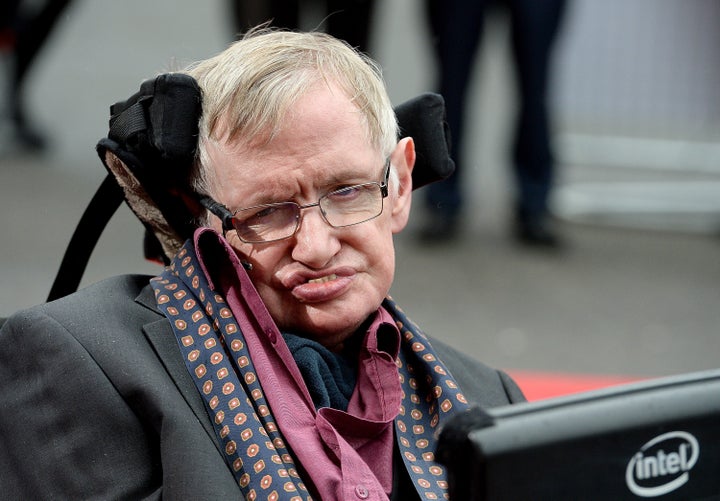
The official news alert announcing that world-renowned physicist Stephen Hawking had died at age 76 popped up on my phone Wednesday, just a few minutes after I first heard about his death. Moments later, my social media feeds were inundated with odes and exaltations to the man who undoubtedly changed the face of physics.
The first image I saw was a cartoon by artist Mitchell Toy. It shows Hawking’s silhouette, standing straight and tall, gazing into the cosmos ― several yards away from his empty wheelchair. Another cartoon followed, this one drawn by Ia Wun Hsu, in which a pixelated Hawking is lifted from his chair and swallowed by a black hole.
The major news networks’ obituaries were no better. CNN’s lede went with “[Hawking] overcame a debilitating disease.” Fox News settled for “[Hawking was] paralyzed but making constant contributions.” NBC noted his wheelchair “didn’t keep him from living a full life.” Al-Jazeera added, “Inside the shell of his increasingly useless body was a razor-sharp mind.” The Washington Post noted, “[Hawking] overcame a devastating neurological disease.” The BBC chimed in that “[Hawking’s] life was a juxtaposition of sparkling intellect and failing body.” The phrase “wheelchair-bound” popped up in the Telegraph and Reason Magazine; the Los Angeles Times opted for the less-subtle “chained to a wheelchair.”
I considered keeping track. How quickly would I be able to fill a page with hash marks for every ableist depiction of Hawking’s disability as a burden or something to escape?
It was disappointing but unsurprising. The way our media portrays disability is fraught with ableism, if disability is depicted at all. I can’t hope to attain even an iota of Hawking’s genius; however, we shared the commonality of being disabled by an incurable condition.
Hawking was diagnosed with amyotrophic lateral sclerosis, commonly referred to as ALS, when he was 21 years old. ALS is a progressive neurodegenerative disease that causes loss of muscle movement, eventually leading to paralysis and death. Hawking lived many years beyond the short life expectancy he was given at the time of his diagnosis.
“Stephen Hawking didn’t discover what he did about the way the universe works 'in spite of' his disability.”
I was diagnosed with Ehlers-Danlos syndrome, or EDS, when I was 27. EDS is an inherited degenerative collagen disorder that causes a myriad of symptoms. Collagen is one of the major structural components of the body ― it is both the bricks that make us up and the mortar between them. When collagen is written incorrectly at a genetic level, the implications can be far-reaching, life-altering and sometimes life-shortening. A run-down of my daily symptoms would easily take up this entire piece, but at its simplest, I deal with incapacitating chronic pain caused by unexpected joint dislocations that occur more times a day than I can count.
My diagnosis answered a lot of questions about mysteries in my medical history ― mysteries I’d spent years trying to solve. It also taught me our society views disability as inherently unfavorable, which then affects our attitudes toward accessibility. You can clearly see that negative association in the above articles; in each of these pieces, the language used describes Hawking’s ALS as something that held him back.
There is no denying that ALS is a deeply debilitating condition that affected every aspect of Hawking’s life in the same way that EDS permeates every aspect of mine. I live in pain every single day, pain that cannot be mitigated by medications and will not be corrected by surgery. I will live and eventually die in an agony that increases with each repetitive injury caused by dislocation.
Many non-disabled people view a life replete with physical anguish as one not worth living. (They’ve told me as much to my face.) They wonder how I do it, how I manage to set out every day and exist with the odds I’ve been given. The reality is that there is no other option. My EDS isn’t something I try to conquer on a daily basis. It’s something I live with; it’s the concrete reality of my existence. There are no cures, no fixes. There is nothing that will unsequence my DNA, unzip the base pairs and re-twine them into a functional double helix that produces normal collagen. I either exist with EDS, or I don’t exist at all. Those are my choices.
As a former mortician, I have seen ― and touched ― the finality of death firsthand. At 31, I’ve decided it’s not my first preference.
Living within a disabled body afflicted with perpetual pain isn’t easy. My body is sometimes a limiting factor on my life. More often, however, what limits me is a world designed to explicitly and implicitly accommodate only the non-disabled subset of the population.
When date night with my fiancé becomes an insurmountable obstacle course because I’m using my wheelchair, I’m not fighting my disability. I’m fighting inaccessibility in a world that says I don’t deserve to participate in the same experiences as non-disabled people. When I can’t access the medications I need because privatized insurance has denied me access, I’m not fighting my disability. I’m fighting a world that says I don’t deserve to manage my illness because it costs Blue Shield too much money. (Hawking fought against privatization of health care to the very end of his life, noting that access to the National Health Service in the U.K. was integral to keeping him alive.) When I’m mocked by non-disabled people for standing up when using my wheelchair, I’m not fighting my disability. I’m fighting a world that refuses to acknowledge that disability is not a binary but an extensive spectrum.
Variation within a species is necessary to strengthen it. Patients with sickle-cell anemia are immune to malaria. Deafness led to the development of the phone, the internet and SMS texting. I suspect EDS patients have a lot to teach astronauts about how their bodies change after long periods of time in space. Hawking himself usually said his ALS gave him more time to think. When the media portrays disability as something within which there are neither positives or neutrals, they fail to recognize that disability is just another genetic variation within the vast species of humanity.
“The way our media portrays disability is fraught with ableism, if disability is depicted at all.”
Language influences and shapes our experience. When the media insists on discussing Hawking’s disability as something he “overcame” or “conquered,” it’s playing into repetitive and inaccurate tropes that describe disability as something that stifles innovation, something that cannot exist beside great intellect, something that staunches creativity. That mindset encourages inaccessibility, the denial of access to medical treatment, the mockery of disability. Perpetually describing disability as negative by default instead of as a normal or neutral form of variation means it becomes something to be eradicated, fixed, removed.
Hawking didn’t discover what he did about the way the universe works “in spite of” his disability. He did so as a disabled human, fully informed by the reality of his existence, living it every single day ― as those of us who are disabled do. Illustrating Hawking, an atheist, walking away from his wheelchair to his afterlife is as offensive an erasure as is the implication that disability and genius, success and satisfaction can’t ever go hand in hand.
Instead of playing into the same tired cliches, it’s time to rewrite the narrative. Accepting disability as one of the myriad ways in which humans can and do exist is the first move toward building a more accepting and accessible world.
Ace Ratcliff lives with hypermobile Ehlers-Danlos syndrome, dysautonomia and mast cell activation syndrome, which all make for a particularly rebellious meatcage. Her advocacy is centered around intersectional feminism with a specific focus on disability rights.
